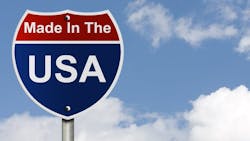Manufacturing minute: 4 must-read articles on tariff-driven reshoring challenges, predictive AI forecasting, and more
Every minute counts in manufacturing—especially when you're chasing uptime, efficiency, and performance. That’s why we created Manufacturing Minute, a curated snapshot of articles worth your time. From real-world reliability wins to smart maintenance practices, we’ve got you covered. Here's what’s trending across the industry this week.
What a Texas Showerhead Salesman Discovered About 'Made in the USA' Labels
Author: Scott Horsley
Source: NPR
60-second snapshot: Texas entrepreneur Ramon van Meer tested whether customers would pay more for showerheads made in the USA by offering both imported and domestic options—only to find zero buyers chose the pricier American-made version. His experience reflects broader challenges in reshoring manufacturing, including high costs and fragmented supply chains. Other U.S. makers like Rick Whedon and David Malcolm echo similar struggles, citing declining local suppliers and limited consumer interest in domestically sourced goods. Despite tariffs aimed at encouraging American production, the reality is that most buyers prioritize price over origin, and reviving U.S. manufacturing won’t happen quickly—or easily.
Learn more
‘It’s just musical chairs’: Brands are moving manufacturing out of China — but not back to the U.S.
Author: Allison Smith
Source: Modern Retail
60-second snapshot: Despite steep tariffs on Chinese imports, most U.S. brands are not bringing manufacturing home but relocating to other low-cost countries like Vietnam, India, and Sri Lanka. High labor costs, limited factory infrastructure, and lack of key components make U.S.-based production impractical for many consumer goods. While a few companies are testing small-scale domestic manufacturing, most are diversifying across Asia to manage risk and costs. Executives say "Made in the USA" remains largely symbolic, as global supply chains remain deeply tied to China’s dominance in materials and manufacturing capabilities.
Learn more
The path to battery leadership for the U.S. starts with tech
Author: Naoki Ota
Source: Fast Company
60-second snapshot: The U.S. currently lags behind Asia in battery manufacturing, with China producing 75% of the world’s batteries and dominating the supply chain. Simply replicating Asia’s model won’t close the gap; instead, the U.S. must lead through innovation in cost, performance, and safety. Core battery designs haven’t changed in decades, and real progress will come from rethinking battery architecture, adopting new materials, and embracing advanced manufacturing techniques. In a recent quote, Naoki Ota said, “If the U.S. wants to pioneer a reimagined industry, we can’t settle for chasing Asia’s playbook. We need to simplify where possible, innovate where it counts, and rethink the battery from the ground up.”
Learn more
How a Robotics Company Is Leveraging Its Competitive Advantages to Manage Tariff Disruption
Author: Anna Smith
Source: IndustryWeek
60-second snapshot: Carnegie Robotics, a Pittsburgh-based robotics sensor manufacturer, is facing both challenges and opportunities amid new U.S. tariffs. While tariffs are making imported components more expensive and harder to source, they are also driving more companies to seek American suppliers. To stay competitive, the company is relying on its skilled workforce to manage costs and maintain pricing, rather than passing increases to customers. A diverse customer base and strategic problem-solving are helping the company navigate a volatile trade environment while preparing for future growth.
Learn more
How Predictive AI Can Help Manufacturers Forecast Demand for Their Products
Author: Zohar Bronfman
Source: Smart Industry
60-second snapshot: Traditional forecasting models rooted in historical trends are failing manufacturers in today’s volatile, fast-changing environment. Predictive AI offers a transformative solution by analyzing real-time, nonlinear data to generate dynamic, probability-based forecasts. Companies like Procter & Gamble and other industry leaders have already seen major improvements in accuracy, inventory efficiency, and cost savings by embracing AI-driven forecasting. By combining machine intelligence with human judgment, predictive AI empowers manufacturers to make faster, smarter decisions and maintain a competitive edge in a rapidly evolving market.
Learn more
About the Author
Alexis Gajewski
Senior Content Strategist
Alexis Gajewski has over 15 years of experience in the maintenance, reliability, operations, and manufacturing space. She joined Plant Services in 2008 and works to bring readers the news, insight, and information they need to make the right decisions for their plants. Alexis also authors “The Lighter Side of Manufacturing,” a blog that highlights the fun and innovative advances in the industrial sector.
